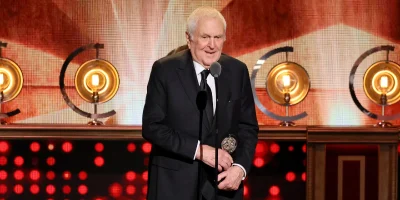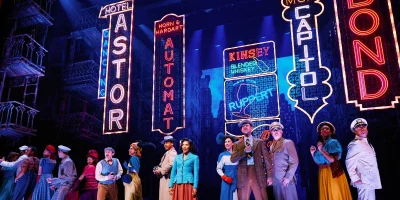
How the 'New York, New York' designers recreated the city on stage
The John Kander, Fred Ebb, and Lin-Manuel Miranda musical takes place in 1946 Manhattan, and the design team spared no detail to authentically capture the era.
Designing a musical called New York, New York on Broadway had the potential to be tricky. One the one hand, the heart of Manhattan is the only logical place for such a show to debut. But on the other, how can onstage replicas of city scenes stack up with the actual city right outside the theatre doors?
It's a challenge the New York, New York team were game to tackle — and their designs proved to be top of the heap. Six designers behind the new mega-musical earned 2023 Tony Award nominations: set designer Beowulf Boritt, costume designer Donna Zakowska, lighting designer Ken Billington, sound designer Kai Harada, and orchestrators Sam Davis and Daryl Waters.
They had one key advantage: time, in two senses of the word. They began work on their designs, together with director Susan Stroman, nearly a year before its March premiere. And the show isn't set in the present: New York, New York takes place in 1946, like the same-named Martin Scorsese film that serves as the show's loose source material. Their city is the backdrop for the story of artists trying to make it big amid a post-World War II boom of hope and opportunity.
Though parallels abound, the designers didn't have to compete with today's city. Rather, they had the opportunity to revive a bygone version of New York that today's audiences might not otherwise have ever seen, or would ever see. The final result combines the familiar and unfamiliar, sonically and visually. Classic Kander and Ebb hits, like the jazzy title song, live alongside new tunes by Kander and Miranda that dabble in a variety of genres. Familiar landmarks appear alongside bygone hotspots and ordinary apartments specific to the characters.
The designers shared how 1940s New York lives on in their designs and how they capture the city's nuances, highlights, and contradictions, all within three hours at the St. James Theatre.

The action of New York, New York spans 70 locations across the city.
Many of these locations are famous landmarks, like the Grand Central train station, Brooklyn Bridge, and Central Park's Bow Bridge. Together, all the settings create a full portrait of the city with visuals that locals and tourists alike will recognize. Visitors in particular will get a full sightseeing tour without leaving the St. James!
Keep an eye out, too, for historic landmarks that are unique to NYC of the past. The set for one scene features marquees for the Selwyn Theatre, now called the American Airlines Theatre, and the bygone Hotel Astor. A large sign reading "Palladium" in another scene hearkens to the Palladium Ballroom, a now-shuttered nightclub that opened, fittingly, in 1946.
The designers were inspired by a piece of 1940s writing.
Amid the famous city sights featured in the set are plenty of ordinary settings, like the characters' apartments and the streets just outside them. "The set is all about windows and fire escapes — places for actors to be, places that imply life and more lives and more stories," set designer Beowulf Boritt explained.
But as the characters in the musical know, more people means it's easy to get lost among them, and there's more competition for jobs and apartments and survival — a struggle that was as relatable in the '40s as it is today. E.B. White wrote about this in his 1949 essay Here Is New York, which inspired the designers.
The author, best known for the bittersweet children's book Charlotte's Web, discussed how New York is "a city where you're in the middle of everything and surrounded by people, and it can be the loneliest place in the world," Boritt paraphrased.
"We've all experienced that at some point," he continued. "That's part of what the physical production is trying to show conceptually: the return and the craziness of New York, and the beauty of New York, but also the harshness of it."

The set was constructed with iron and steel, just like the real city.
Most people don't think about all the individual parts that make up New York's famed skyscrapers — or elaborate Broadway sets. But New York, New York shines a spotlight on them. One of the musical's most buzzed-about scenes is a tap dance routine performed on a "floating" steel beam.
Like actual beams used in construction, the onstage ones are actually plated with steel. And those aforementioned fire escapes? "We're dealing with 10,000-pound iron fire escapes!" Boritt said. "It's not paper and plywood... that's part of what gives it the weight and feel of New York."
The scenic backdrops are hand-painted.
One way New York, New York specifically evokes the 20th-century city is with a now-rare technique. Projection design is now common in theatre, and the New York, New York team could have used projections to depict the skyline at various angles throughout the show. According to Boritt, a lot of audiences assumed that's exactly what he did.
But he felt it would be truer to the 1940s to use hand-painted backdrops, a "dying art" he wanted to preserve. The musical features 12 of them, each 3 feet wide and 35 feet tall. Irina Portnyagina, a Ukrainian artist who's collaborated multiple times with Boritt, created eight.
"[She] retired to Amsterdam, and I brought her back to New York to paint the show," Boritt said. "She painted every day from the beginning of October until we were halfway through tech, getting them all done.
"As soon as I realized people thought we put a video wall up there, I thought, 'No!'" Boritt continued, with mock exasperation. "It's real old-school Broadway, and it's done in a way that does look kind of like modern technology."
His vision matched that of Zakowska, who wanted to achieve a "painterly quality" with her costumes.

The show's music and dance influences are just as diverse as the city itself.
"[The show features] every style from Afro-Cuban numbers to tap to ballet to a violin concerto to opera," co-orchestrator Sam Davis shared. Kander and Lin-Manuel Miranda have written an eclectic score that reflects the characters' varied backgrounds.
The jazzy, brassy sound of Kander and Ebb's songs from the original New York, New York movie all remain, though. The title track is so famous that the creators knew messing with its sound would get them "killed" by audiences, Davis joked.
Early drafts of the score featured more music than what made it to Broadway.
According to Davis, the show featured 4,000 bars of music at one point. For context, a three-minute song averages around 90 bars. Multiply that by the 28 numbers in the final version of New York, New York, and you'd arrive at 2,520. That's a huge difference — the cut material could probably make another hour's worth of show!
Still, 28 numbers means New York, New York boasts one of the most robust scores on Broadway. A show that seeks to capture the hustle and bustle of the city, with the symphony of sounds that fill the streets every day, requires nothing less.
Photo credit: New York, New York on Broadway. (Photos by Paul Solnik; first in-article image by Emilio Madrid)
Originally published on



